Shoes are the foundational piece of a well-dressed man’s wardrobe; no matter how expensive your wardrobe is, a bad pair of shoes can ruin everything. As choosing the right shoes is crucial and can make or break an outfit, we’ll discuss whether or not a gentleman should wear loud, colorful, and flashy dress shoes (and when such shoes could be worn) to avoid looking clownish.
Most traditional dress shoes come in colors ranging from black over burgundy, to oxblood, to mate, or chestnut brown, to maybe lighter brown, or tan or some darker, chocolatey brown. Why are those colors so popular? Well, they’re easy to combine, they don’t stand out too much, they provide a bit of contrast, and are just considered to be classics.
However, if you go back in history, it wasn’t always like that, and today, you can wear pretty much anything you want – meaning you can pull off a pair of purple shoes, orange, green, or whatever color you want including silver, gold, and rainbow colors.
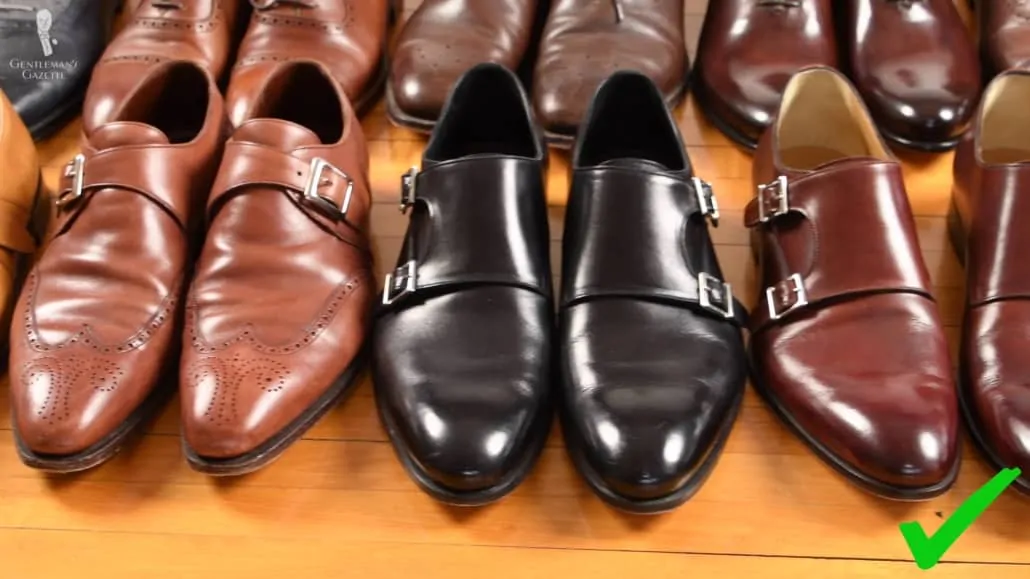
As always though, just because you can, doesn’t mean you should. Generally, quality dress shoes are an expensive investment and most people out there don’t have an unlimited budget. So, if you want to buy a shoe that you can wear 5, 10, or even 20 years down the line, buying that two-tone purple shoe is probably not a great investment.
The History of Men’s Dress Shoes
The history of shoes reveals a surprising element of color in men’s shoes. Shoes, as we know them today, have their origins in Europe and have always been synonymous with status and wealth since the Gothic and Middle Ages.
Back in the day, materials were expansive, tanning was a dirty business, and cobblers were highly-coveted craftsmen. The vast majority of peasants and servants weren’t able to really afford nice shoes. They had rudimentary pieces of material on their feet, and the left and the right shoe looked exactly the same. The style of those shoes was usually rather boxy and maybe serves as the inspiration of boxy shoes today.
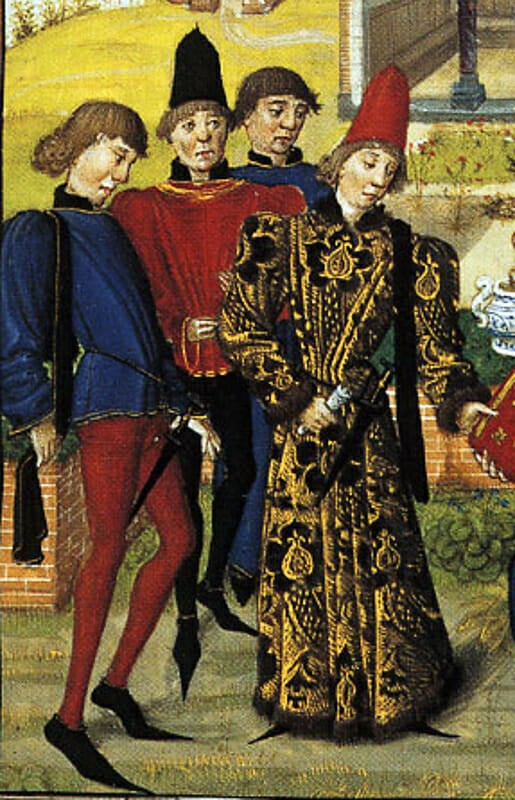
On the flipside, royalty and people associated with accord had more effort put into their shoes, which meant they had a pointy shape. Also, they were made of more expensive materials such as velvet.
The longer the point of your shoe was the higher class you were because it signaled that you didn’t really have to work. They didn’t have to be practical. They just had to show your status and wealth. These shoes here were known as “poulaine,” and they required actual special lacing so you could even wear them.
Renaissance: Heeled Men’s Shoes
Moving on to the Renaissance, shoes changed and developed a heel, specifically for men. Today, it would probably be something that most men would consider to be feminine, but going back in history, the heeled shoe was actually made for men.
They were colorful, sometimes the heel was different from the uppers, and they also had buckles that were sometimes quite decorative and today, we would call them “bedazzled.” So, the original French shoes really have a very close resemblance to the platform shoes today.
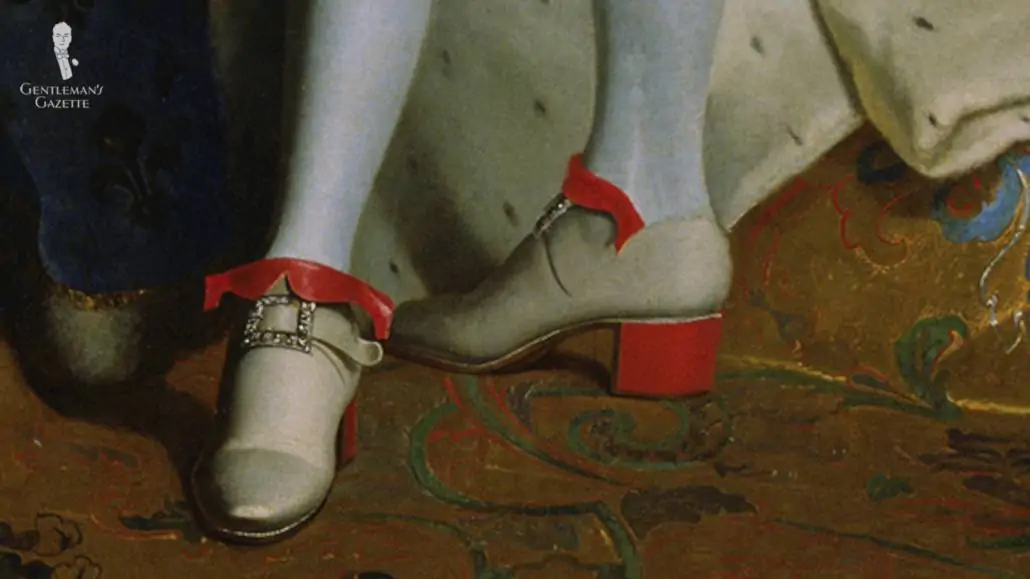
Men who showed off their toned legs in silk stockings were a beauty standard popularized by King Louis XIV. And if you think that was bold, hold your breath and look at shoes from the Baroque Era.
Baroque Era: Shoes Have Even Louder Ornaments
Historically, that’s probably when shoes were the loudest and most flamboyant. Silk, velvet, embroidery, and even ribbons, all on men’s shoes. The wealthy would sometimes also use exotic skins, and all types of detailed materials and silk, velvet, fabrics, and everything that made you look rich, including gemstones, laces, and even bright red heels.
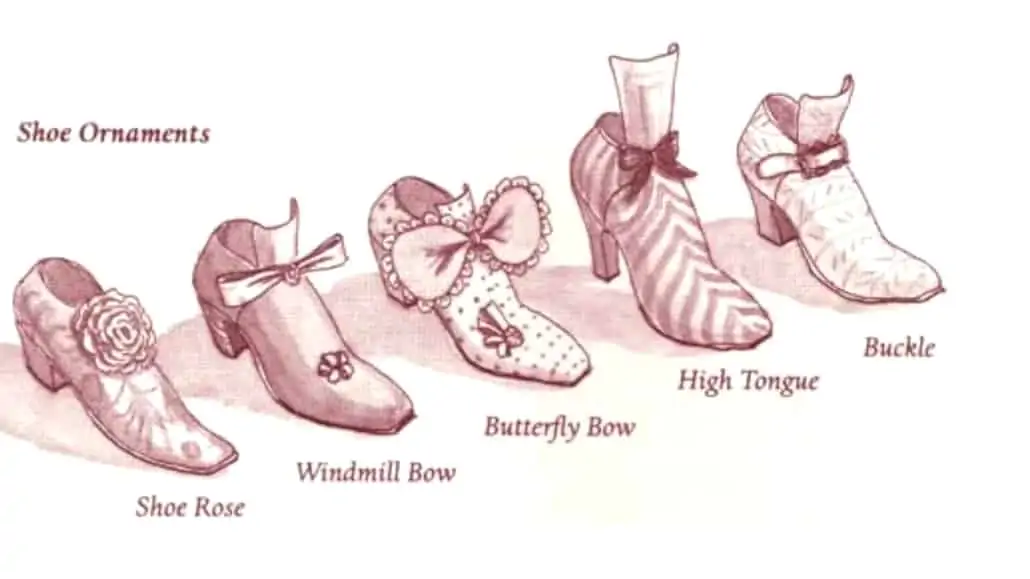
Looking back at all these colorful shoes shows you that the idea of men’s fashion or manliness is a hundred percent defined by society and the environment you live in. Wearing makeup, colorful clothes, and bold, loud, colorful shoes with embroidery and gemstones used to be as manly as it is today for a man to drive a truck, go ice fishing, and buck hunting.
Industrialization: The Birth of The Left Shoe & The Right Shoe
Surprisingly, it wasn’t until the Industrial Revolution, starting around the 1830s, that men had shoes for a left and a right foot. Of course, the influence of Beau Brummell made the entire men’s color landscape more muted and somber.
Even the most classic men’s dress shoe today – the Oxford shoe – had its origins in women’s wear. Yes, Oxfords and Balmorals were women’s shoes, and then, slowly but surely, were adapted into the men’s wardrobe. Just like the fedora, they picked up popularity with men and then, especially, young men, such as students at Oxford, would wear those shoes in that style, and then, it became known as the Oxford shoe.
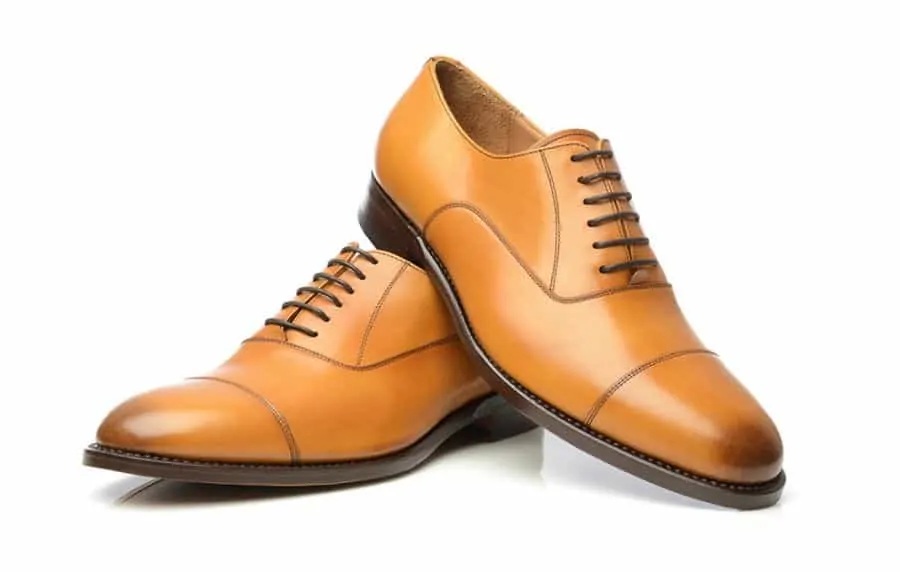
Most shoes at the time were conventional, but there were still special things such as a spectator, which John Lobb claims to have invented in order to play cricket.
A hundred years ago, nubucks or suede were also still a little less conventional and oftentimes, considered to be less expensive and less desirable, and material for the lower classes. Someone started wearing white bucks though during summer and sometimes year-round, and so, the material became more popular. Still, for conservative men, it wasn’t the leather or the shoe of choice because it wasn’t quite up to par.
The King of Rock and Roll, Elvis, liked to wear blue suede shoes. In fact, he liked them so much that he even released the track called “Blue Suede Shoes.” Because of that, blue suede shoes became a popular counterculture item in the 1950s.
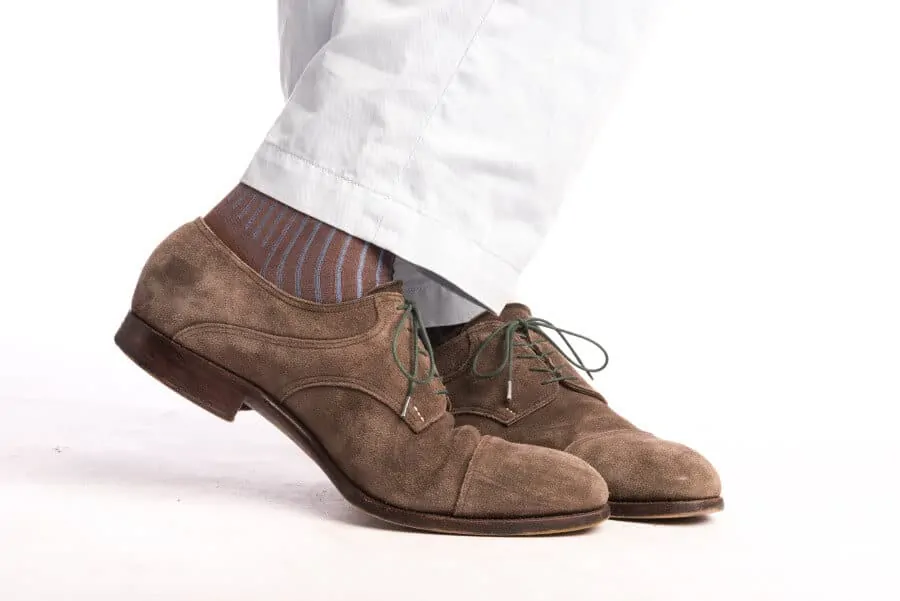
As you know though, eventually with cultural evolution, dress shoes became less important. And now, sneakers are what most men wear today. That being said, there has been a resurgence in classic men’s clothing. And with the help of the internet and improved supply chain technologies, you have many companies now that offer made-to-order options that allow you to get shoes in pretty much any color under the sun right from your computer.
Should You Invest in Colorful, Flashy Shoes?
The short answer is: It depends! It goes without saying that your personal tastes, preferences, and environment play a huge role in this. Leaving it aside, it will come down to what you already have in your wardrobe and what you don’t. If you are still starting out, our guide to The First 5 Dress Shoes You Need to Start a Shoe Collection will help you.
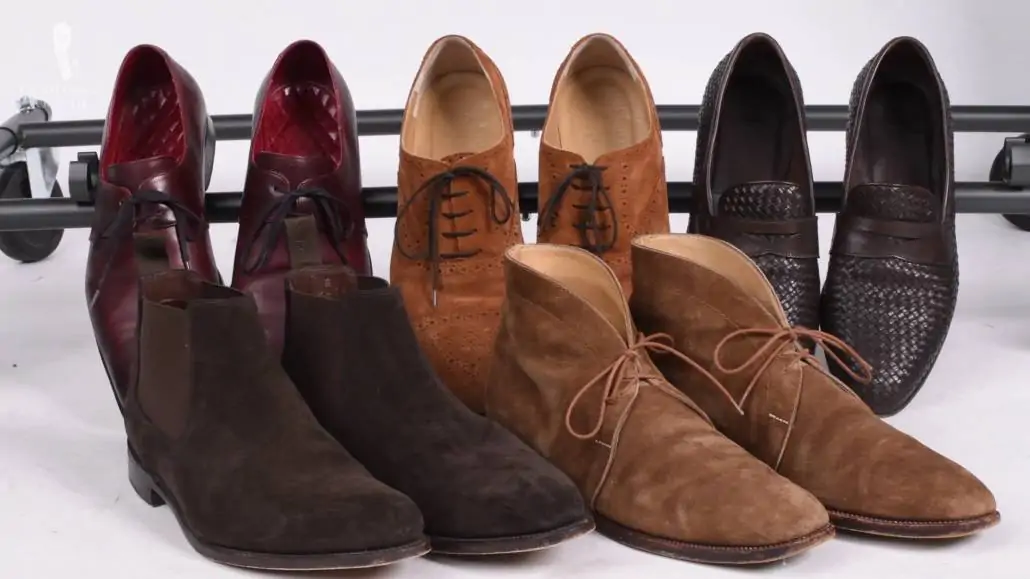
For example, if you work for a conservative law firm or CPA firm and you don’t want to draw too much attention to yourself, wearing a bold, yellow pair of dress shoes is probably not the way to go. On the flip side, if you’ve already got all the classics and you’re interested in something a bit more whimsical or something a little more different that makes you stand out from the crowd in a subtle way, maybe an olive green pair of shoes or something gray could be a really good addition.
How Can You Pull Off Bold Dress Shoes?
You probably don’t want to look like a clown, a pimp, or a carnival character, so what’s the line and how do you pull off colorful shoes?
1. Invest in All the Classics
First, before you buy a single pair of bold, colorful dress shoes, I suggest you invest in all the classics because they’re versatile and provide a much better value. I’m sure you hear me, a purple shoe is very difficult to combine with most items in your wardrobe.
But even a classic like a white bucks shoe may only work with maybe a seersucker suit or pants. When you wear them, you want to make a statement that says, “Hey, look at me!” And if you want that, then go for it. If not, be aware of it.
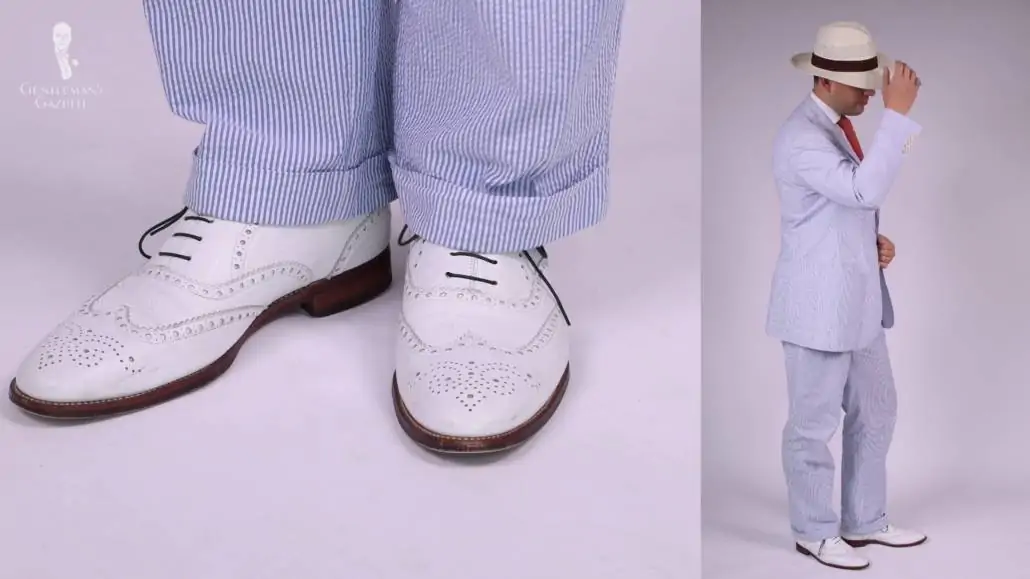
Because colorful shoes are so different, people will see them first and then the person wearing them. And by the third time you wear your brown and white spectators, people will probably know you, “Ah! This is the guy with the crazy shoes!”
The advantage of darker, more conventional colors is that they fly out of the radar, and people won’t even notice until a second or third glance. They can also be paired much more easily with most colors in a classic men’s wardrobe.
The same is true with pretty much any dark color; a navy shoe, a dark green shoe, or even a truly dark purple shoe will not be something that people notice right away. Grey can be a great color for boat shoes or for boots, and so can blue.
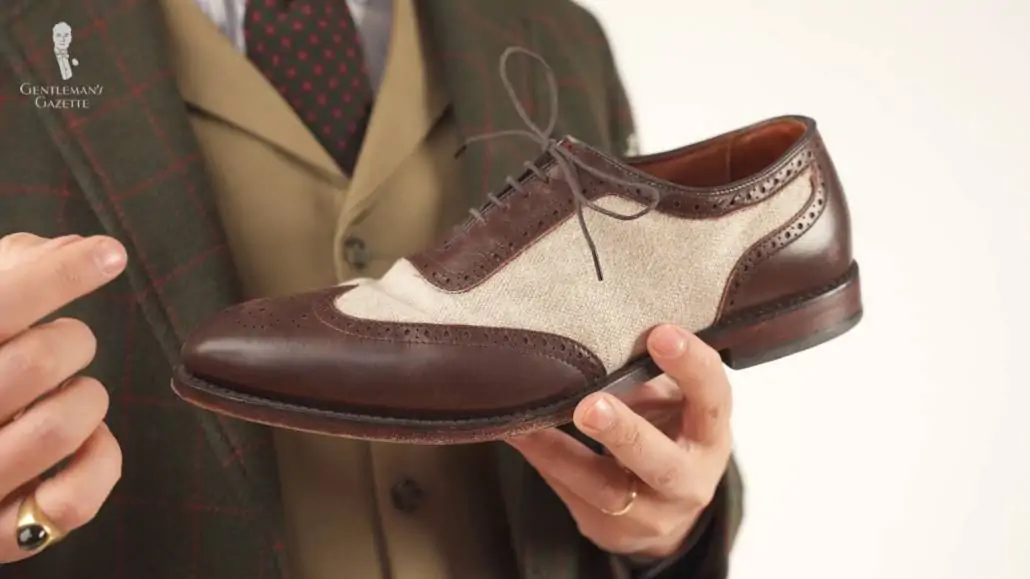
However, the darker the color, the easier it is to combine with your outfits. The lighter the color, the bolder it gets, the more attention you attract. Sometimes, if you like preppy outfits, you want something that is loud in multiple colors. And I own boat shoes, for example, which are more casual, and so I, sometimes, like to have a yellow pair of boat shoes or a blue and red pair of boat shoes. For dress shoes, on the other hand, everything that is too bright has a very limited level of usefulness.
2. Experiment with Textures
Other than just with shoe colors, you can also experiment with different textures. The more texture you have in a shoe, the more casual it gets. When you combine it with color, you can play around a little bit.
For example, a dark brown leather shoe will not draw a lot of attention. However, if you have woven leather, it immediately makes it more casual without being overly loud. Plus, in the summer, it is a great shoe because the woven leather makes the leather more breathable so your feet won’t be sweaty.
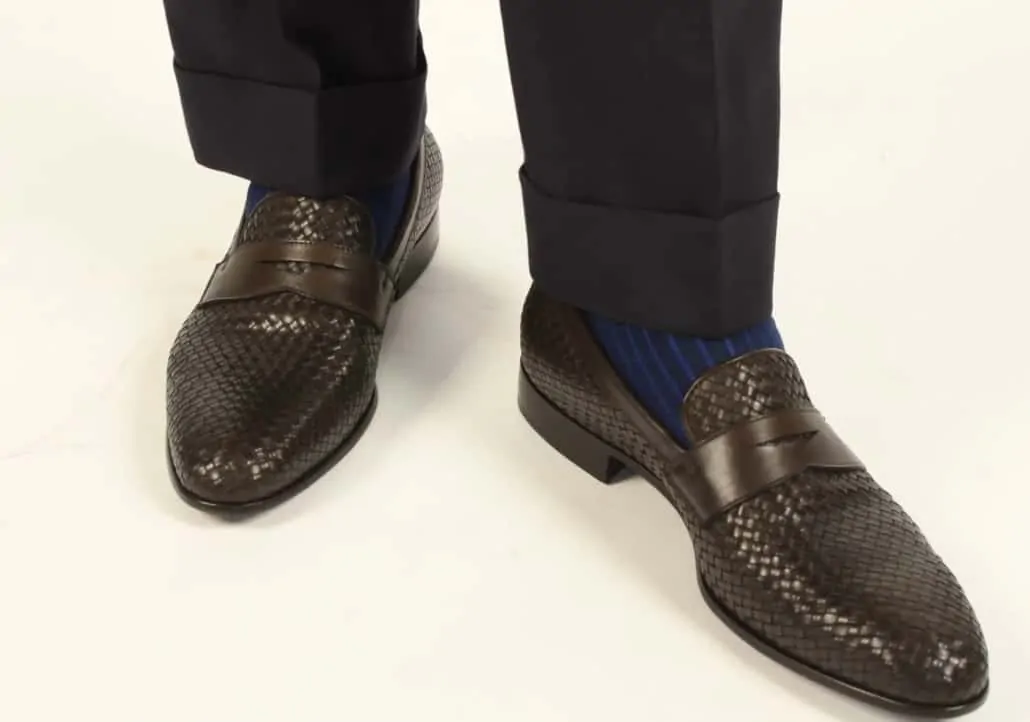
Of course, you can also find embossed leather shoes that look like they’re woven leather when in fact they aren’t. You can also enhance certain colors by having a mix of suede and calf leather in your shoe. Let’s say you have a black or a brown mixed calf and suede leather in the same color, it is louder than a plain suede or a plain calf leather shoe, but it’s not as loud as a pair of boots that have black leather and white suede.
If you go back in history again, this was actually a style quite popularly worn by gentlemen, especially with formal morning wear, and it triggered the interest in spats. So, you couldn’t afford a pair of two-tone shoes, you could wear the spats to give the impression of having that two-toned look.
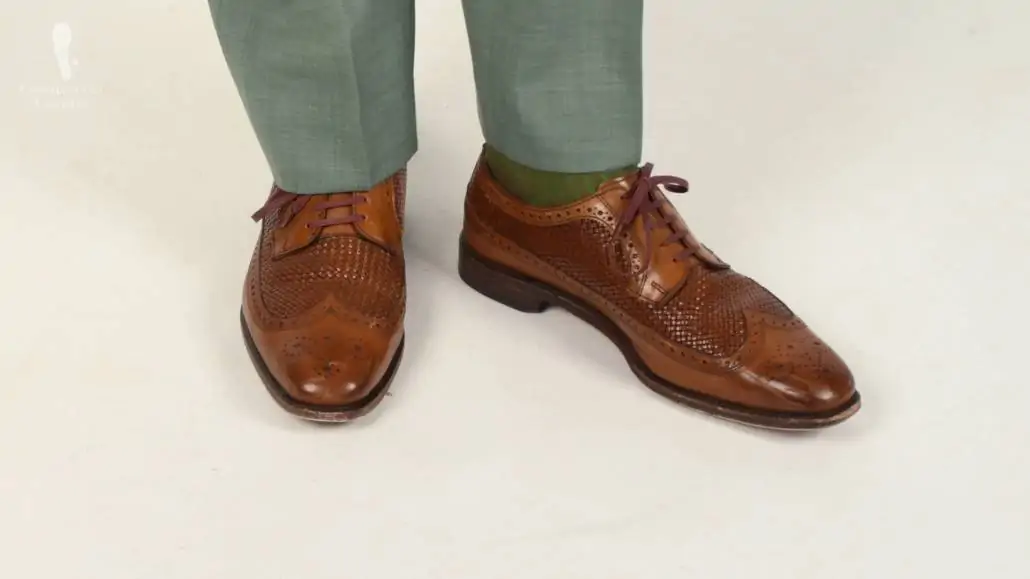
Again, what’s popular, manly, or classic always depends on the society around you. And it’s interesting to see how those standards have changed over time. That being said, the cap toe Oxford has been a staple in a classic men’s wardrobe for the last 100 years, and it likely will be for the next hundred. But who knows what the future holds?
So, you want to take it up a notch? Colorful bold shoes with exotic leather or a blend between exotic and calf leather are even more eye-catching than suede. When it comes to patterned, textured, or colorful shoes, the less contrast you have, the easier it is to wear them and combine them with your wardrobe.
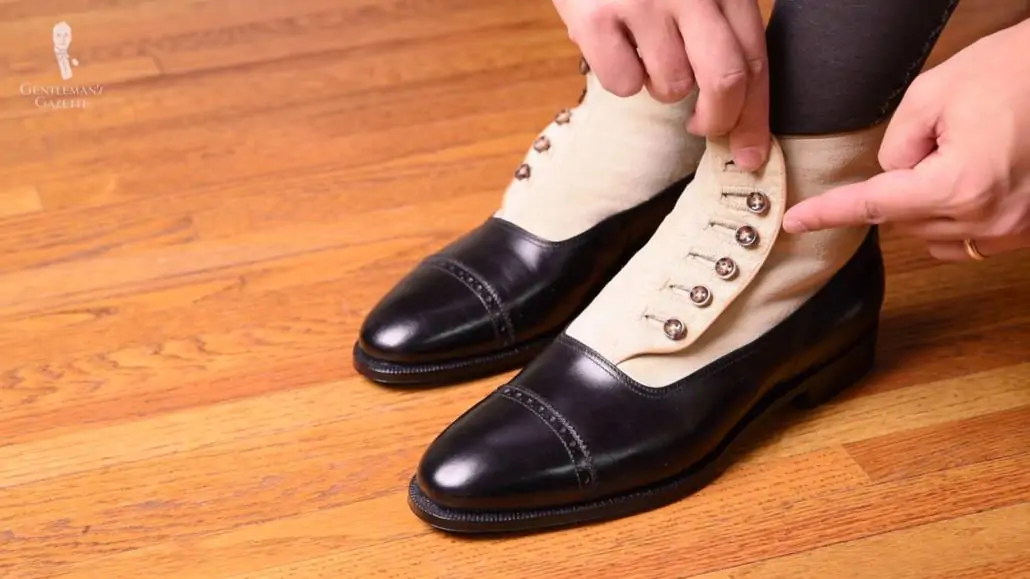
For example, there’s a black and white button boot, so the style is unusual, the color combination is bold; it’s definitely something you’ll get noticed in. Another example is a brown and white calf leather wingtip Oxford. The materials are the same, but it’s still a rather bold shoe. As our last example, a shoe with a mix of navy calf leather and gray suede can have less contrast between the colors, so it’s a little more subtle, but still much more noticeable than the black capital Oxford.
3. Invest in Colorful Shoelaces
Now, let’s say you have shoe colors in black, various shades of brown, oxblood, and burgundy and you wish you could have something that’s a bit more daring? You don’t just have to go out and buy a pair of new shoes in one specific color that you may only wear five times over its lifespan. You can also invest in colorful shoelaces because they cost less than $10 and they’re reversible.
So, if you have a brown pair of shoes and you add a yellow pair of shoelaces, it looks like an entirely new shoe, but if you don’t like the look anymore after a day or two, you can just exchange them and put them in a different pair of shoes.
Experimenting with little things that are easy on your wallet and that are not permanent, maybe a great first step to see if you’re comfortable with the attention you’re getting.
For a broad selection of quality men’s dress shoe laces and boot laces in round and flat styles in many colors, please check out our shop here.
Wearing Colorful Shoes in a Gentlemanly Way
Now, let’s assume you already bought the colorful shoelaces, you’ve played with it, and you want to take the next step. How do you actually wear colorful shoes in a tasteful, gentlemanly way?
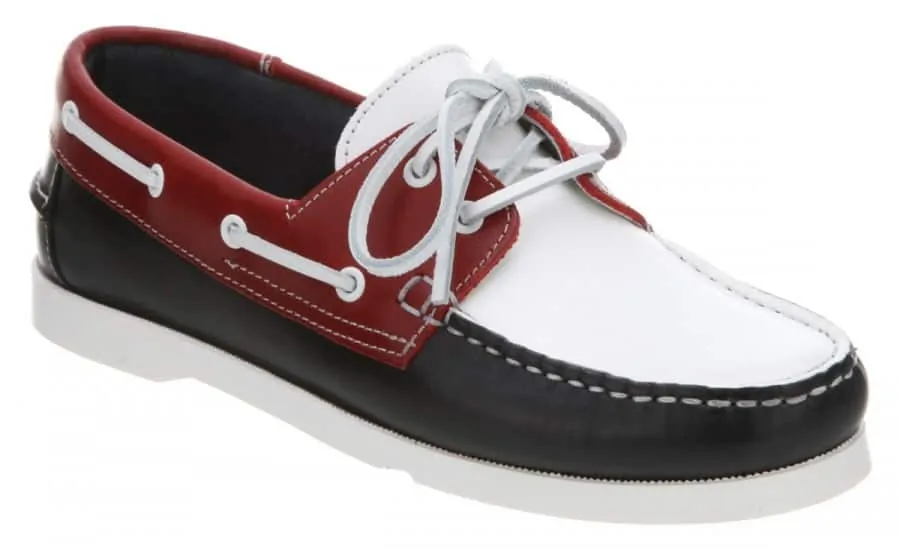
It’s always easier to implement color in more casual shoes than it is in dress shoes. So, introducing color into a sneaker, into a driving moc, or a boat shoe is much easier than into a cap-toe Oxford.
1. Olive Green Dress Shoes
One of the first colorful shoes I suggest you invest in, if you’re at that point, is an olive or dark green shoe because it combines very easily with the rest of your wardrobe. It is not something that shouts, “Look at me! I have green shoes!” But it’s something that people will notice maybe at the second glance.
Just like how brown is the dominant color in men’s dress shoes, green is a natural color. And because of that, it combines very easily with black, navy, blue, charcoal brown, and gray.
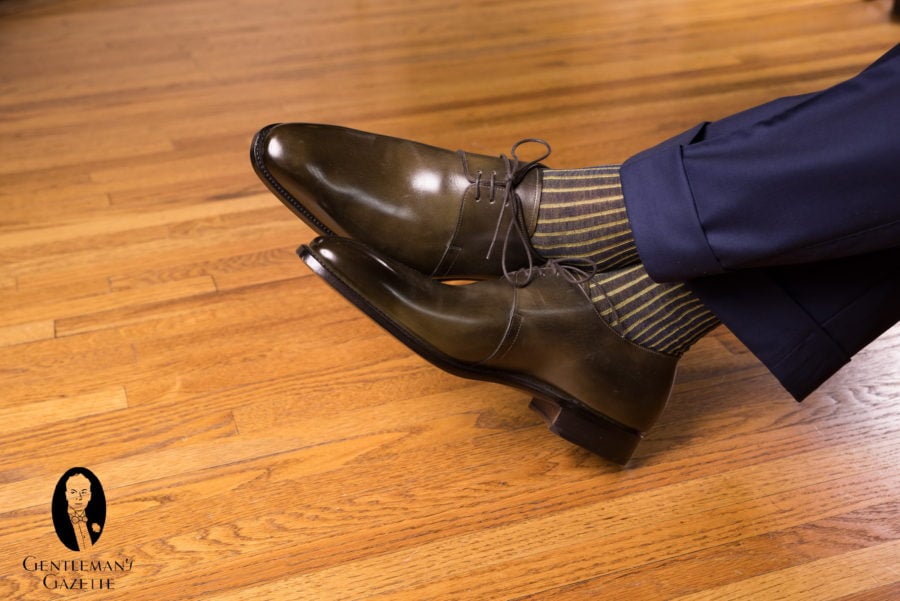
Maybe green derby is a good first alternative or a loafer. You can also have an Oxford but if you go for that, maybe go for a Wingtip or something with broguing that makes it more casual, rather than a plain capital one.
You can also go with suede in that color, which is particularly nice during the warmer months of the year, but also during the fall. Of course, it’s even easier to maybe have a green pair of boat shoes.
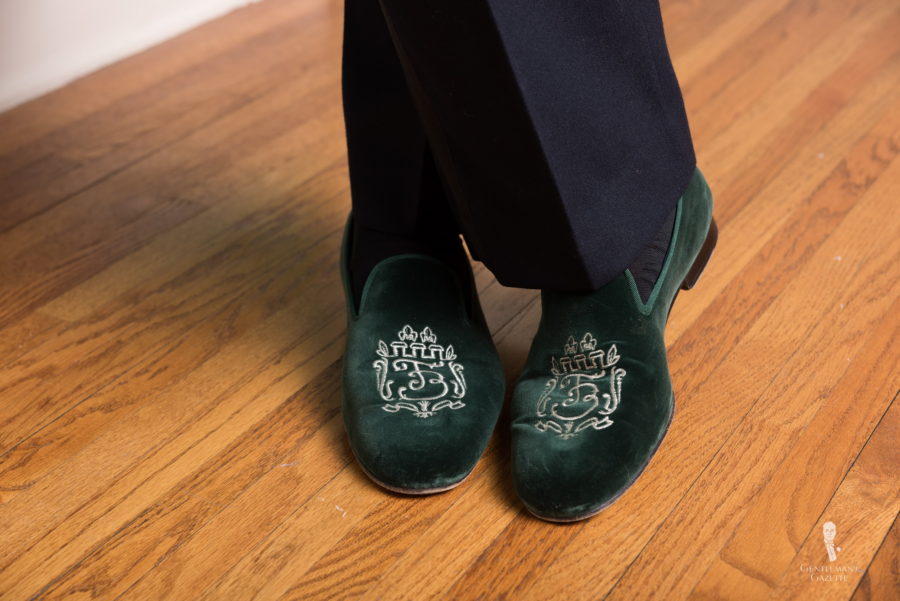
An outfit example would be a green fresco jacket, blue and white-striped seersuckers with green suede tassel loafers, and a pan on my hat with a matching green band tying it all together, having a little pop of color in the orange silk knit tie, and a light blue boutonniere that picks up the tones of blue.
So, having some green in your jacket, your tie, maybe your socks, or your pants will make it much easier to incorporate a green shoe into your wardrobe.
1A. Navy Dress Shoe
Fortunately, most men already have some green accessories so olive green or darker green is a no-brainer to start. That being said, if green sounds too bold for you, maybe start with a dark navy because it’s very close to black and it’s something that allows you to ease into the colorful shoe realm.
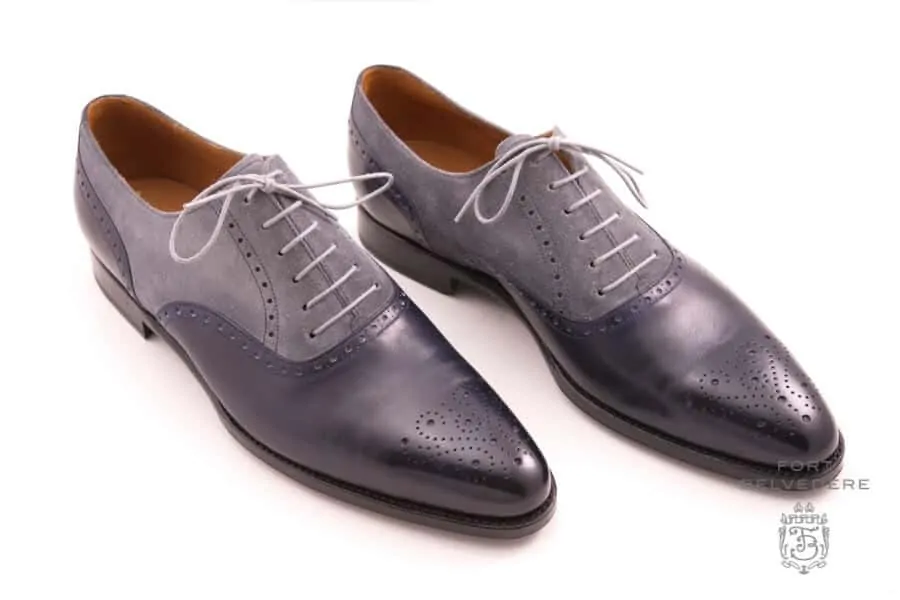
It looks great with navy suits, but can also be worn with gray flannels. It can also blend into business outfits or if you want it to be a little more noticeable, you can think about a spectator or two-tone shoe, such as a pair in lighter navy calf leather and gray suede.
2. White Buckskin Shoe
Once you have a green or navy shoe, the second choice is probably the white buckskin shoe. Even though it used to be a really popular men’s item, today, it’s actually hard to find a buckskin leather shoe or a deerskin leather shoe, which is actually a quite nice leather; it’s rather soft. I found the company Shoepassion offers them, and this is the one I have in my collection.
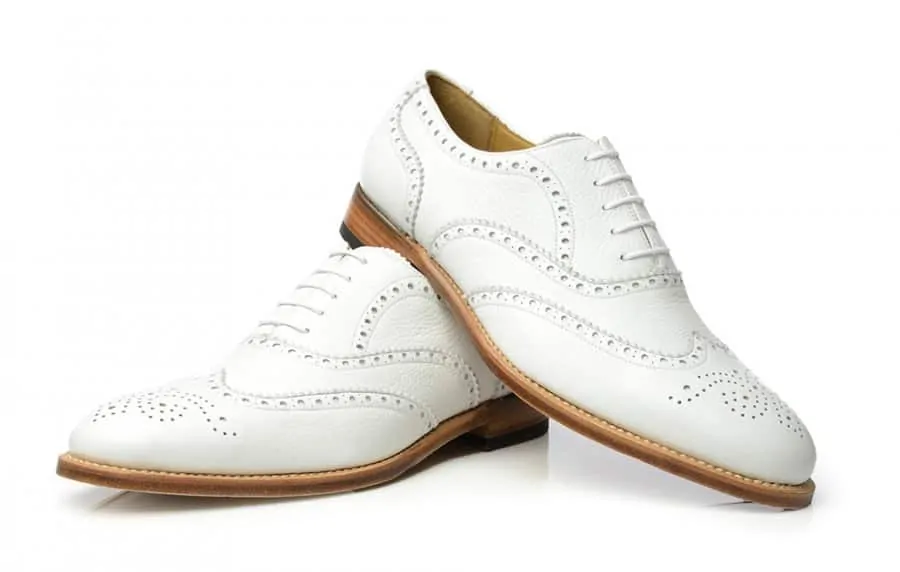
While they’re bold, they work really well as a summer shoe with all types of seersuckers or linen pants or even fresco. Look at the white as kind of like the backdrop of your entire outfit that just lightens everything up. Even though it’s bold, you can also combine it with pretty much any other color, thus, rendering it quite versatile.
3. Spectator Shoe
Once you get the white buckskin summer shoes, it’s time to think about a nice spectator. The most classic one is probably the one in brown and white, and you can even have black and white, but it’s a little harsher of a contrast and I find they’re harder to incorporate into outfits.
Wearing brown and white two-tone shoes will immediately give your outfit a vintage 1930s flair. One of the first things many people say is “Oh! Al Capone!” and they associate spectator shoes and striped suits with that period in time, but also with mobsters.
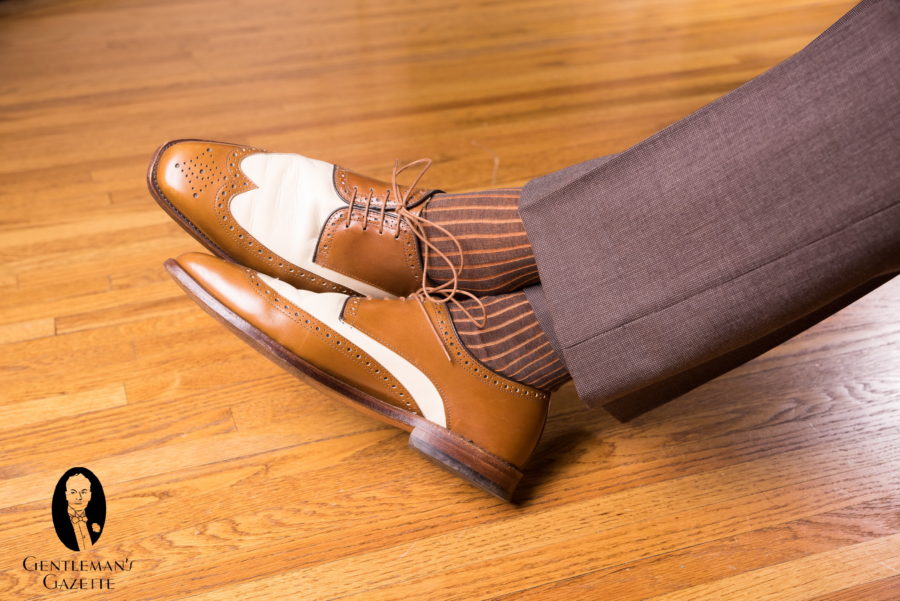
The good thing about white and brown is that it works with any kind of earthy, natural tone, but you can also wear it with a grey suit or even a navy striped suit. Yes, it’s bold but it still works.
Instead of leather, you can also find spectators made of canvas, typically not kind of white canvas but it’s darker. It’s like khaki or fawn or tan, which means less contrast and, therefore, easier to combine with other outfits. It’s a cool, classic alternative to the brown and white or, in general, spectator shoe in all leather.
4. Grey/Mid-blue Shoes
Once you have the spectator in your rotation, I think a gray pair of shoes is really underrated or maybe something in blue that’s a little lighter than navy.
Gray can work really well during the summer because it’s very neutral. It can be combined with a lot of colors. At the same time, it’s not as noticeable or loud as a white buckskin shoe. So you can wear them with chinos. I even have gray boat shoes, which you can combine with different pairs of shorts and polo shirts very easily.
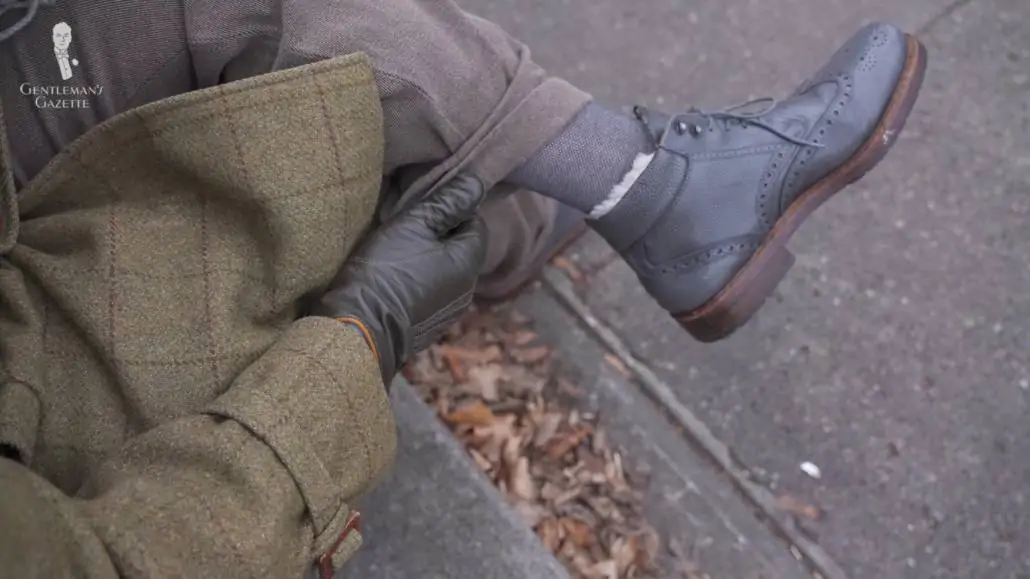
Preston has a nice pair of derbies, which look really well on him and are quite versatile. I also have a pair of gray winter boots that are lined in wingtips with kind of a scotch grain leather. They always look good.
Blue shoes are a little harder to combine and I find myself wearing them less often, but I know others who like them quite a bit. Let’s say you have blue shoes and blue pants, it creates a monochromatic look and it’s more noticeable than a grey shoe in my opinion. It just looks a little more artificial and like you want more attention.
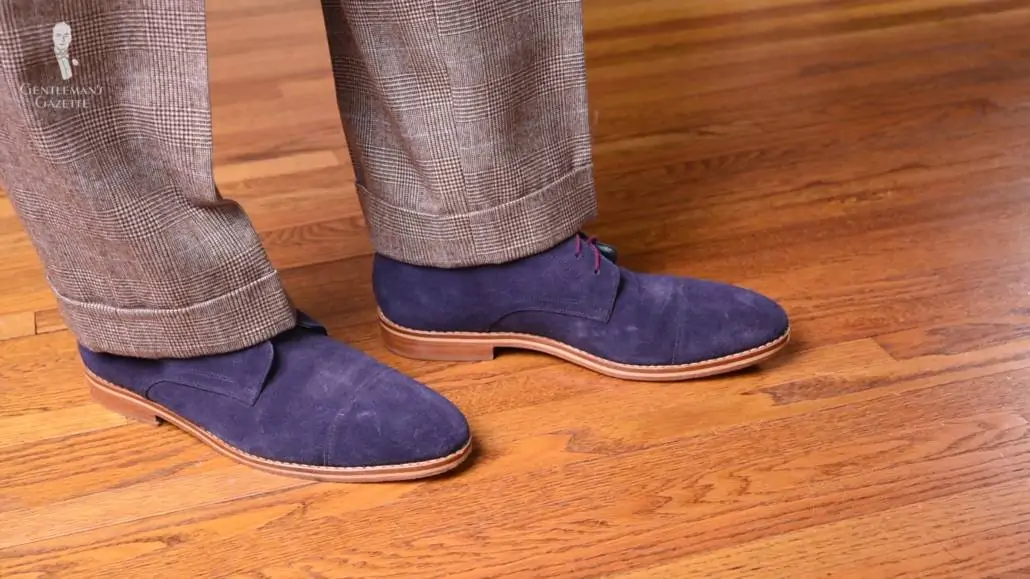
If you want to try experimenting with other colors such as orange or yellow or purple, it’s probably best to not do it with classic dress shoes but think about a driving mocc, think about a sneaker, or a boat shoe.
In any case, before you make the purchase, I suggest you consciously think about what outfits and what items in my wardrobe can I combine this pair of shoes with? You’d be surprised how few outfits you can actually wear with a purple shoe.
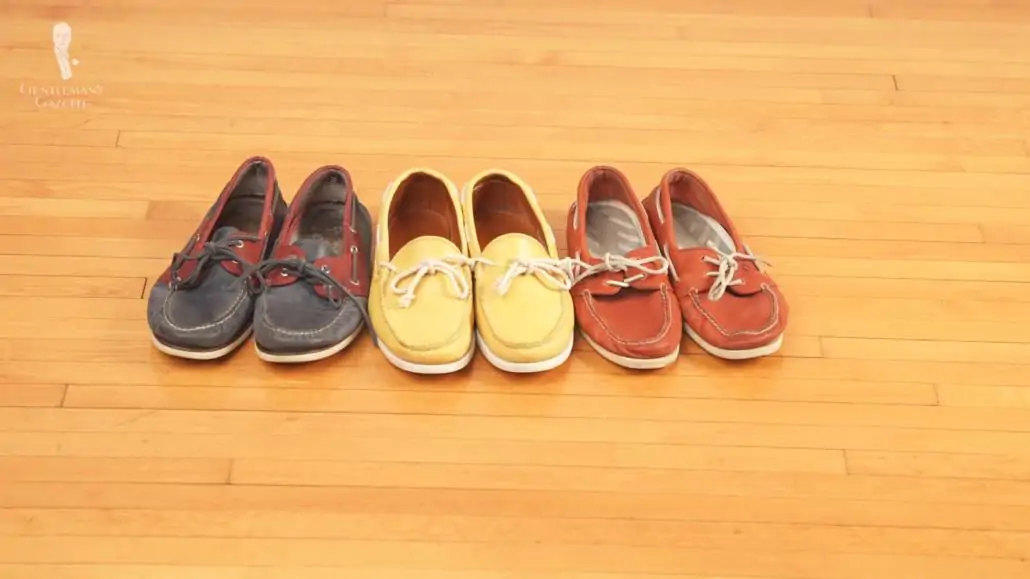
Personally, I’m a big fan of bolder, colorful shoes for my casual boat shoes in the summer that I typically wear with other seersuckers or some cotton or linen shorts. I have them in blue and green, and navy and red, and kind of orangish-red. I have them in yellow, in gray and blue with tan two-tone. I also have some in white with tan, and it’s just fun to wear them.
Of course, I also have the classic brown boat shoes, but whenever I can, for a casual wardrobe, I just like that pop of color that makes me stand out from the crowd and defines my personal summer style.
What Should You Avoid?
1. Overly Bold Patterns, Textures, and Colors
First of all, having shoes with extremely bold sequins or colorful flower patterns is just something that is not really part of the realm of a classic men’s wardrobe today, and it just makes you look like a bold artist. And if that’s what you want to go for, by all means, invest in those shoes.
But, if you’re here, chances are you’re interested in classic men’s clothing and that’s simply not part of that. I know I said conventions are a hundred percent defined by the society we live in at the time, but the fact is, we live today and that’s what the conventions are and they have been that for a long time.
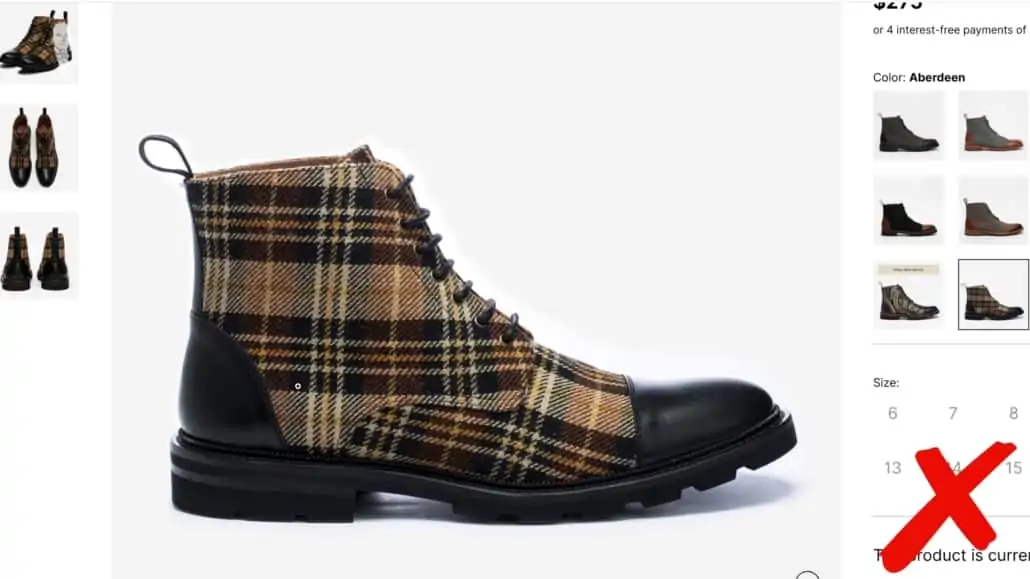
If your shoes have all kinds of patterns, it makes it hard to wear with other patterns in your outfit because you have one more dimension to consider when putting together things. Bold pattern shoes also draw the attention away from your face towards your shoes and they always will be the centerpiece of the outfit.
2. Shoes Made From Fabric
Keep in mind that cotton and canvas are materials that are very summery; they’re breathable, they have that nice casual look but they also wear it a lot more quickly than leather does. Once they’re stained, they’re a lot harder to clean, so just something to keep in mind.
That’s why other than, for maybe, canvas or fabric boat shoes or canvas alpargatas for summer wear, I think fabric shoes are ideal for areas where they don’t get a lot of wear and use, which is typically around the house.
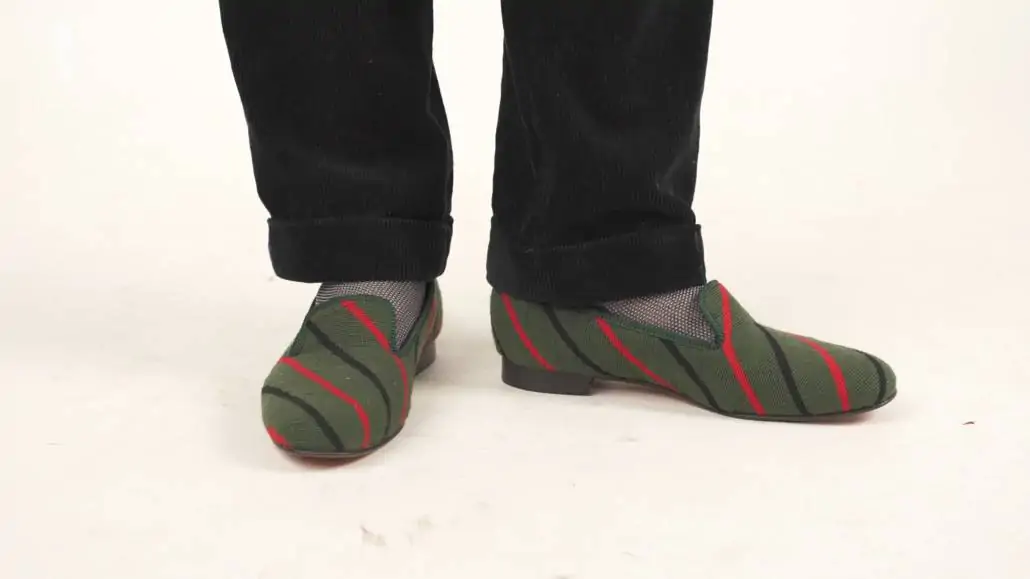
I’m a big fan of fabric Albert slippers and I have them in green velvet or in needlepoint green with red and black stripes, which is quite cool and unusual.
Once you have 50, 60, or even 100 pair of shoes in your wardrobe, the question of longevity really becomes a moot point because even if you wear a different pair of shoes every day, you only get three, four, five, or six wears out of each pair of shoes per year, and so you probably won’t have to resole a shoe anymore, unless you wear some more often than others.
Conclusion
While they are not very apparent in classic menswear, bold and colorful shoes have their time and place and can be implemented in classic outfits. Having the knowledge of when and where they should be worn can help you put your best foot forward and choose the right shoe to match and complete a timeless and stylish outfit, without the risk of looking funny.
Do you have bold and colorful shoes in your collection? How do you wear them? Let us know in the comments!
Outfit Rundown
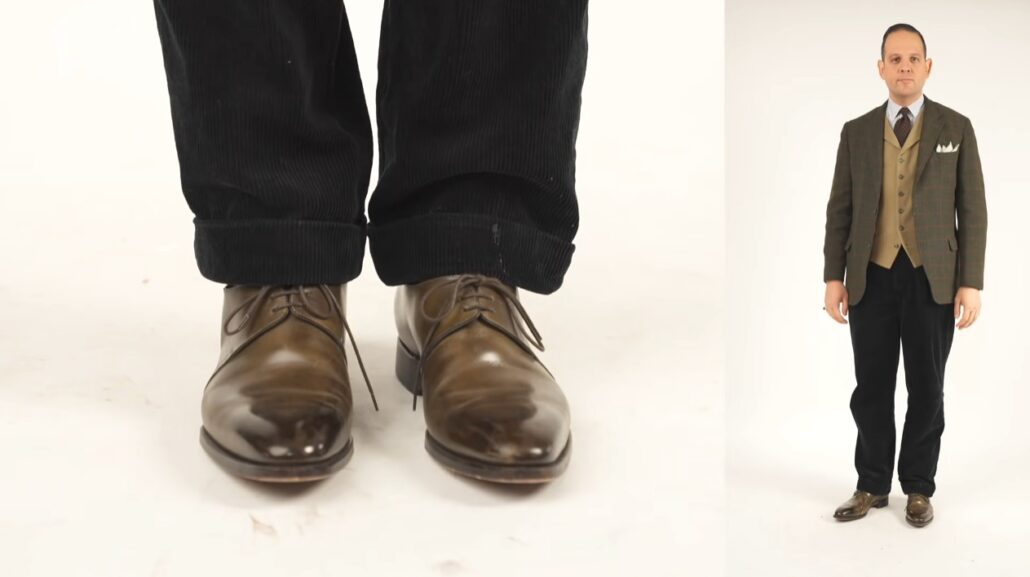
In today’s outfit, I’m, of course, wearing colorful green shoes. I went with an olive green. It’s a darker shade and kind of a more modern, elongated last. The shoes are made by a Carlos Santos from Portugal, and they work well with my jacket, which is green tweed with an orange overplaid.
My tie is wool shelly from Fort Belvedere that has green, red, and yellow in it; combining it with a fine striped shirt that has green in it. My vest is fawn-colored, which is kind of a shade of green. I’m combining it with black corduroys by Polo Ralph Lauren and socks in black and white. They are these two-tone socks that look like a solid gray color from afar, but actually have black and white elements. They are from Fort Belvedere. I designed them. They’re over-the-calf and you can learn more about them in our shop here. The pocket square is a light green with contrasting green stitching; picks up the color of the shirt and the vest; and while still green, it has a nice contrast compared to the jacket, and you can find it in our shop here.
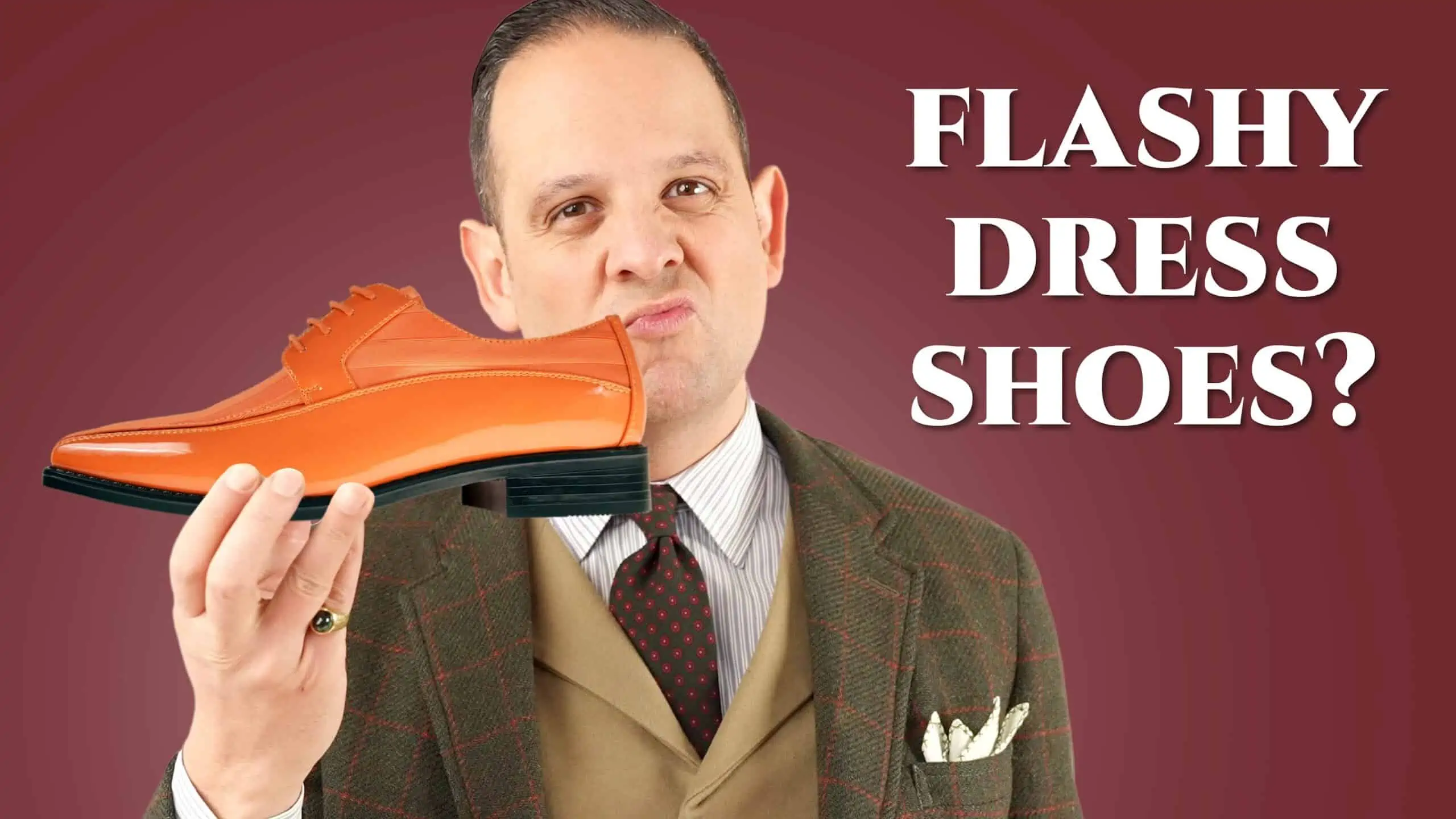
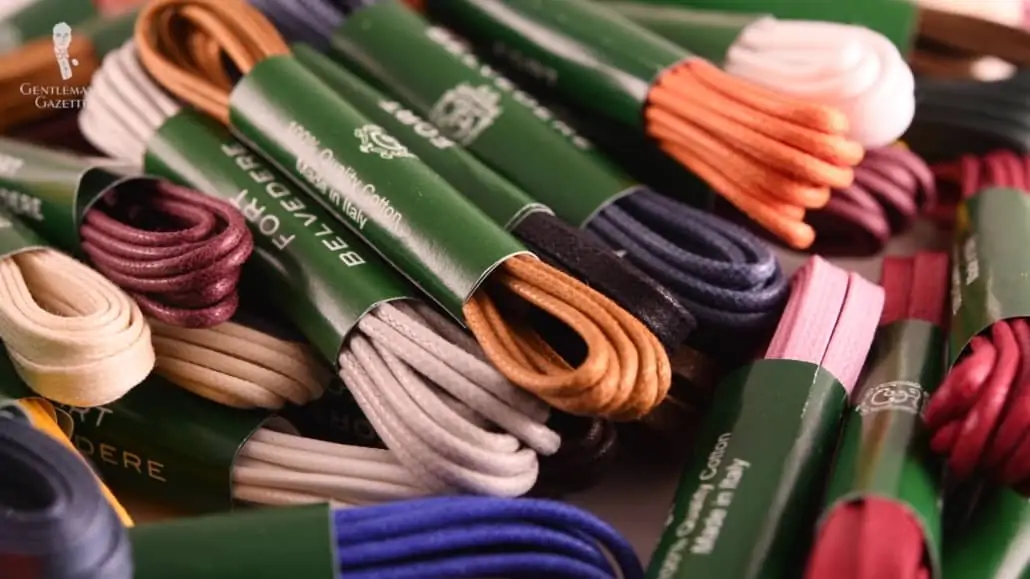
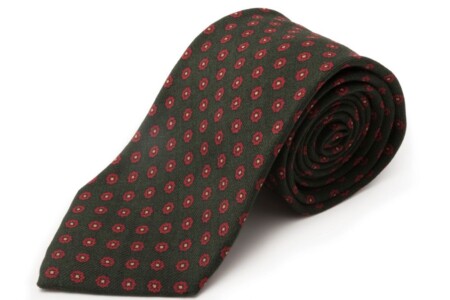
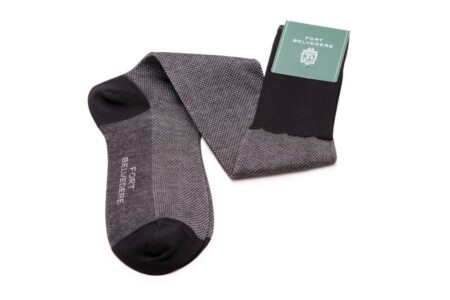
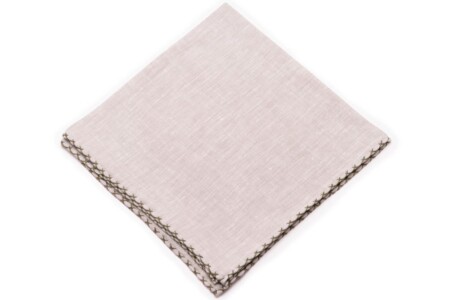
The outfit that Raphael is wearing in this video is one of my favorites (maybe just because it looks like one that I would wear; I actually own a pair of Carlos Santos shoes in green bosco patina). I particularly like the sport coat. But I was a bit disappointed that he didn’t say that the shoes worn by the guy in the Bruegel painting (around 2:00) make him look like a peasant. (Readers who have been following these videos for a long time will recognize the reference.)
A counterexample to the assertion that cloth materials are suitable only for summer shoes is an English country shoe or boot that has calfskin toes, facings, and counters but cloth-covered vamps, such as Herring Exmoors.
Thanks Miles
“Blue Suede Shoes” was written and first recorded by Elvis’ friend, Carl Perkins. Elvis’ nemesis. Pat Boone, popularized white “bucs” at about the same time. You know these things when you’re really, really old!!
Great article though, lots of information.
Interesting! Thanks for sharing, Greg. :)
It is (to me, anyway) a surprising fact that gray is a less versatile color in shoes than is, say, brown. I recently acquired a pair of gray suede chukkas and have been struck by how often they fail to “work” with one or another pair of trousers. Gray is by definition an achromatic color, and for this reason one might expect it to be a neutral color. But it seems to me that neutrality in colors is relative to the kind of item of clothing in which it occurs, and depends on custom. Gray is neutral in a coat or a pair of trousers, but not in a pair of shoes, because it is an unusual color in the latter, at least in modern men’s dress shoes, but not in the former. If anyone insists that all achromatic colors are neutral, then I will qualify my claim to say that gray is not *functionally* neutral in men’s dress shoes.
As a matter of fact, you’re not alone with your obversation. I also like my gray casual suede shoes, but tend to observe they only work well with blues and greens while looking a bit “bland” with khakis and grays (that are one of the default choices for pants), almost like the sartorial equivalent of noodles with potatoes. Brown, by contrast, works with all of the mentioned choices.
Interesting article. My own thoughts below:
Personally I would only ever wear formal black shoes (oxfords, light brogues, slip-ons) with a suit for town wear. Brown ones are okay for tweed in the country or with chinos, cords, moleskins etc.
Suede I would keep for desert boots or chukka boots and informal
In the UK two-tone formal shoes are called co-respondent (as in a divorce case) shoes and as the name indicates have a rather spivvy image, albeit they are very rarely seen these days. Wearing these will soon get you a name for eccentricity.
Again in the UK, grey shoes are seen as very low class. Not sure why, but there it is. They shout photocopier repair man.
Yellow I would say is okay for Timberland boots worn with jeans.
White – only for trainers.
Other colours and combinations? Only if you want to be noticed, and not necessarily in a good way.
I respect that the men in the UK have a more conservative approach to menswear than those of is in the US. It seems as if we are determined to learn the rules of good dressing just so we can break them. As a younger man I was certainly guilty of this. As I have aged, however, I find that I appreciate a more conservative approach. Maybe there is hope for us after all.
Thanks for sharing your thoughts, Nick!
Contrast button boots, or as I call them, pseudo spats? Very hard to look anything but costumey. (A word?). If you are entering a Nathan Detroit lookalike contest perhaps, but if not, as Nancy Reagan used to say, “Just say no.”
Great article for guidance. I have a fairly healthy collection of shoes. Unfortunately I am somewhat anal retentive in that each pair serves a specific purpose in my wardrobe. I do have some of the colors mentioned above, grey, blue, and white, primarily in my summer rotation. Additionally I have 2 pair in tourquois, strictly casual wear. But I just am not a fan of bolder less traditional colors. I am a firm supporter of you do you, I guess I am just to old to be that adventurous.